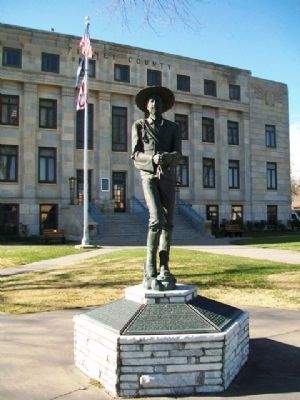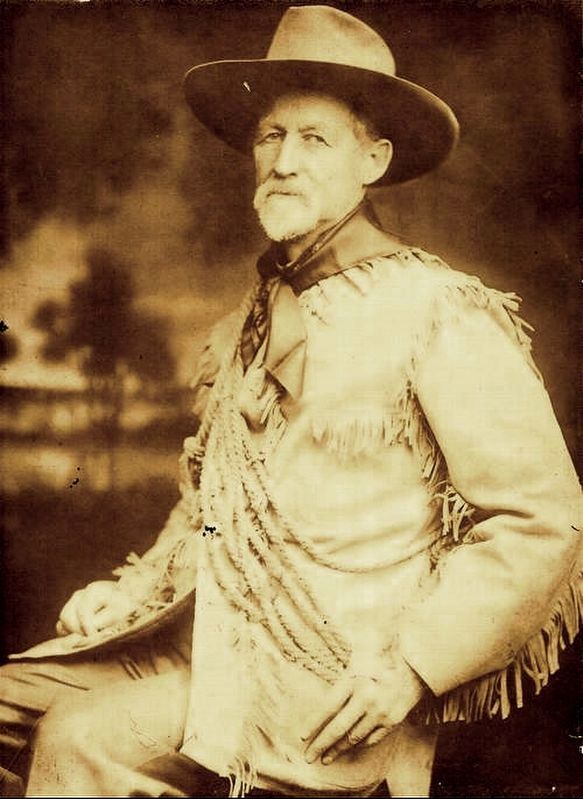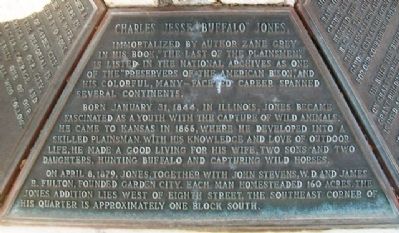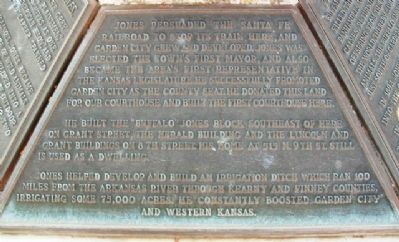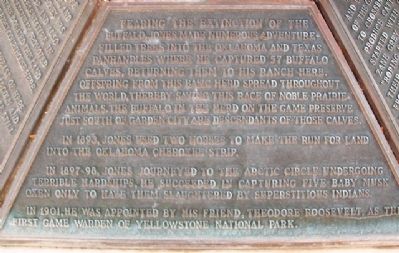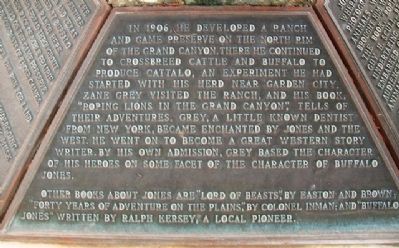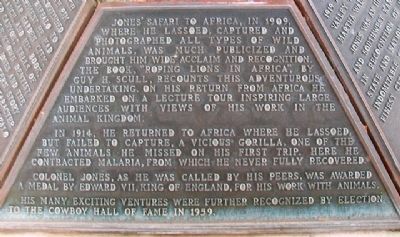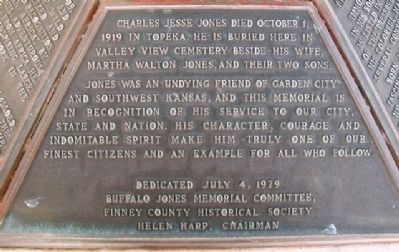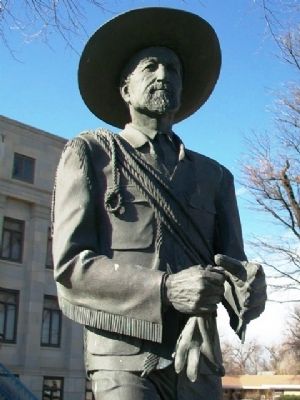Garden City in Finney County, Kansas — The American Midwest (Upper Plains)
Charles Jesse "Buffalo" Jones
[Panel 1]
Immortalized by author Zane Grey in his book, “The Last of the Plainsmen,” is listed in the National Archives as one of the “Preservers of the American Bison,” and his colorful, many-faceted career spanned several continents.
Born January 31, 1844, in Illinois, Jones became fascinated as a youth with the capture of wild animals. He came to Kansas in 1866, where he developed into a skilled plainsman. With his knowledge and love of outdoor life, he made a good living for his wife, two sons and two daughters, hunting buffalo and capturing wild horses.
On April 8, 1879, Jones, together with John Stevens, W.D. and James R. Fulton, founded Garden City. Each man homesteaded 160 acres. The Jones Addition lies west of Eighth Street. The southeast corner of his Quarter is approximately one block south.
[Panel 2]
Jones persuaded the Santa Fe Railroad to stop its train here, and Garden City grew and developed. Jones was elected the town’s first mayor, and also became the area’s first representative in the Kansas Legislature. He successfully promoted Garden City as the county seat. He donated this land for our courthouse and built the first courthouse here.
He built the “Buffalo” Jones Block southeast of here on Grant Street, the Herald Building and the Lincoln and Grant Buildings on 8th Street. His home at 515 N. 9th St. still is used as a dwelling.
Jones helped develop and build an irrigation ditch which ran 100 miles from the Arkansas River through Kearny and Finney counties, irrigating some 75,000 acres. He constantly boosted Garden City and western Kansas.
[Panel 3]
Fearing the extinction of the buffalo, Jones made numerous adventure-filled treks into the Oklahoma and Texas panhandles where he captured 57 buffalo calves, returning them to his ranch here. Offspring from this basic herd spread throughout the world, thereby saving this race of noble prairie animals. The buffalo in the herd on the game preserve just south of Garden City are descendants of those calves.
In 1893, Jones used two horses to make the run for land into the Oklahoma Cherokee Strip.
In 1897-98, Jones journeyed to the Arctic Circle. Undergoing terrible hardships, he succeeded in capturing five baby musk oxen only to have them slaughtered by superstitious Indians.
In 1901, he was appointed by his friend, Theodore Roosevelt, as the first game warden of Yellowstone National Park.
[Panel 4]
In 1906, he developed a ranch and game preserve on the North Rim of the Grand Canyon. There he continued to crossbreed cattle and buffalo to produce cattalo, an experiment he had started with his herd near Garden City. Zane Grey visited the ranch, and his book, “Roping Lions in the Grand Canyon,” tells of their adventures. Grey, a little known dentist from New York, became enchanted by Jones and the West. He went on to become a great Western story writer. By his own admission, Grey based the character of his heroes on some facet of the character of Buffalo Jones.
Other books about Jones are “Lord of Beasts,” by Easton and Brown; “Forty Years of Adventure on the Plains,” by Colonel Inman; and “Buffalo Jones” written by Ralph Kersey, a local pioneer.
[Panel 5]
Jones’ safari to Africa, in 1909, where he lassoed, captured and photographed all types of wild animals, was much publicized and brought him wide acclaim and recognition. The book, “Roping Lions in Africa,” by Guy H. Scull, recounts this adventurous undertaking. On his return from Africa he embarked on a lecture tour inspiring large audiences with views of his work in the animal kingdom.
In 1914, he returned to Africa where he lassoed, but failed to capture, a vicious gorilla, one of the few animals he missed on his first trip. Here he contracted malaria, from which he never fully recovered.
Colonel Jones, as he was called by his peers, was awarded a medal by Edward VII, King of England, for his work with animals.
His many exciting ventures were further recognized by election to the Cowboy Hall of Fame in 1959.
[Panel 6]
Charles Jesse Jones died October 1, 1919 in Topeka. He is buried here in Valley View Cemetery besides his wife, Martha Walton Jones, and their two sons.
Jones was an undying friend of Garden City and southwest Kansas, and this memorial is in recognition of his service to our city, state and nation. His character, courage and indomitable spirit make him truly one of our finest citizens and an example for all who follow.
Dedicated July 4, 1979
Erected 1979 by Finney County Historical Society.
Topics and series. This historical marker is listed in these topic lists: Animals • Environment • Exploration • Settlements & Settlers. In addition, it is included in the Former U.S. Presidents: #26 Theodore Roosevelt series list. A significant historical month for this entry is January 1899.
Location. 37° 58.13′ N, 100° 52.523′ W. Marker is in Garden City, Kansas, in Finney County. Marker is at the intersection of 8th Street and Pine Street, on the left when traveling north on 8th Street. Memorial is in the county courthouse grounds. Touch for map. Marker is at or near this postal address: 425 North 8th Street, Garden City KS 67846, United States of America. Touch for directions.
Other nearby markers. At least 8 other markers are within walking distance of this marker. Replica of the Statue of Liberty (a few steps from this marker); In Memory of Our World War Heroes (within shouting distance of this marker); The Little Finnup House (about 400 feet away, measured in a direct line); Windsor Hotel (about 500 feet away); State Theater (about 600 feet away); Garden City History (about 600 feet away); Stevens Park (about 700 feet away); Sabine Hall (Garden City High School) (approx. ¼ mile away). Touch for a list and map of all markers in Garden City.
Related marker. Click here for another marker that is related to this marker.
Also see . . .
1. Charles Jesse "Buffalo" Jones. Kansapedia website entry (Submitted on June 11, 2013, by William Fischer, Jr. of Scranton, Pennsylvania.)
2. Charles Jesse Jones. National Park service website entry (Submitted on September 15, 2023, by Larry Gertner of New York, New York.)
Credits. This page was last revised on September 15, 2023. It was originally submitted on June 11, 2013, by William Fischer, Jr. of Scranton, Pennsylvania. This page has been viewed 1,340 times since then and 60 times this year. Photos: 1. submitted on June 11, 2013, by William Fischer, Jr. of Scranton, Pennsylvania. 2. submitted on September 15, 2023, by Larry Gertner of New York, New York. 3, 4, 5, 6, 7, 8, 9. submitted on June 11, 2013, by William Fischer, Jr. of Scranton, Pennsylvania.
